|
A number of diseases can affect lawn grasses. Disease-causing fungi are almost always present in the soil, waiting for a time when conditions are right to attack. The most common times are when your lawn is under stress. Examples of environmental stress are excessively wet or dry weather and exceptionally hot or unseasonably cool temperatures.
As well as reacting to weather conditions, lawn diseases can also indicate soil problems. Any part of a lawn can be affected. Slopes, depressions, high traffic and shady areas are all vulnerable.
Mowing too short or watering too much or too little, thatch and compacted soils all increase the chances of disease in your lawn.
Diseases often start as yellow, tan or brown areas of varying sizes in the lawn. Before you assume you have a lawn disease, make sure it isn't something else. Injury, stress or deficiencies can produce similar symptoms and also set the stage for infection. These are often things that you can control, so it's wise to recognize and remedy these situations.
To help you identify whether the problem is injury, stress or a deficiency, we have listed some examples and solutions below.
Note: These problems are applicable to all turf grasses in many cases Eco-Lawn will not be susceptible to these diseases.
Problem:
Gray or dull brown fat caterpillars that destroy young plants by cutting them off at the soil line.
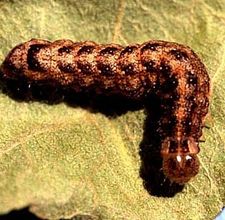
Organic Solution:
Typically, Eco-Lawn is not as susceptible to cutworms as it has naturally occurring endophytes, which are a beneficial natural fungi that grows within it. Cutworms feeding on endophytic Eco-Lawn grass blades is deterred because of this fungal toxin within Eco-Lawn. If you do have a cutworm problem, sprinkle cornmeal around the areas where you see cutworms. They can't resist eating it and overeating cornmeal results in their death. Alternatively, beneficial nematodes can be used to suppress populations as is spraying the affected area with Bacillus thuringiensis, a widely available caterpillar killing bacterium, is also effective.
Non-organic Solution: Cutworms are susceptible to several turf insecticides check with your local garden centre or hardware store for options in your area.
Problem:
Larvae suck the plant juices from the grass producing yellow patches in the lawn. To diagnose, spread the grass and look for small red and black bugs with a white stripe across their bodies.
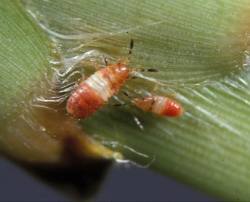
Organic Solution:
Although Eco-Lawn tends not to have problems with Chinch Bugs, if you do spot them, regular watering of the lawn will often eliminate them. You can also spray the affected areas with a mixture of Safer's Insecticidal Soap and water every two or three days for a week or so.
Diatomaceous earth can also be used to control Chinch Bugs. Diatomaceous earth is an insecticidal dust which acts as an abrasive. It cuts the outer layer of the chinch bug's body causing it to dehydrate and then die.
Non-organic Solution: Chinch Bugs are susceptible to several turf insecticides check with your local garden centre for options in your area.
Problem:
Grubs are the larvae of Junebugs, European Chafers and Japanese Beetles. These C-shaped larvae create damage that looks similar to drought stress as they eat the roots of the lawn. The tunnelling larvae are an invitation to moles, skunks and other predatory mammals which, in turn, dig up the lawn in search of a meal.
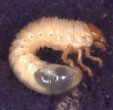
Organic Solution:
In nature, the adult beetles prefer to lay their eggs in moist soils such as streambanks and pond edges. With Eco-Lawn, once it is mature, the watering requirements are minimal thus the surface of the soil tends to be hard which is unattractive to female beetles looking to lay their eggs, so you get far fewer grub problems with Eco-Lawn. However, if you do experience a problem with grubs beneficial nematodes can be used to control them.
Non-organic Solution: Grubs are susceptible to several turf insecticides check with your local garden centre or hardware store for options in your area.
Problem:
Billbugs are weevils whose larvae eat grass blades resulting in small dead patches that look like Dollar Spot disease. To diagnose, pull up the turf. If the stalks break easily at the ground level and the stems are hollowed out or packed with sawdust, Billbugs may be the culprit.
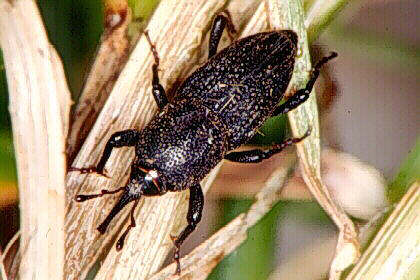
Organic Solution:
Eco-Lawn is not as susceptible to Billbugs as it has naturally occurring endophytes, which are a beneficial natural fungi that grows within it. The feeding of Billbugs on endophytic Eco-Lawn grass blades is deterred because of this fungal toxin within Eco-Lawn. If you do have a Billbug problem beneficial nematodes can be used to suppress them.
Non-organic Solution: Billbugs are difficult to control using insecticides because their armor-like bodies to not readily absorb the chemicals. They also do not ingest much insecticide when they penetrate a grass stem while feeding. Contact your local garden centre or hardware store for options in your area.
Problem:
The adult moth does not damage turf but they lay their eggs in turf. The caterpillars emerge in early spring and tunnel under thatch in the day while feasting on grass blades at night. Damage appears as small dead brown patches in the lawn, typically on sunny, steep slopes where it is hot and dry. To diagnose use your fingers to part the grass blades in the area between the dead and live grass and look for small green pellets. These are the excrement of the larvae.
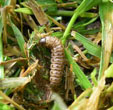
Organic Solution:
Eco-Lawn is not as susceptible to Sod Webworm as it has naturally occurring endophytes, which are a beneficial natural fungi that grows within it. The feeding of Sod Webworms on endophytic Eco-Lawn grass blades is deterred because of this fungal toxin within Eco-Lawn. If you do have a problem with Sod Webworms beneficial nematodes can be used to suppress them.
Non-organic Solution: Sod Webworms are susceptible to several turf insecticides check with your local garden centre for options in your area.
Problem:
Red Thread is a fungus that thrives in cool, humid environments and appears as small pinkish-red spots or patches about 4 - 8 inches in diameter, which eventually turn light tan in colour. It is most severe in nitrogen deficient soils.
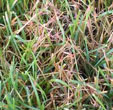
Organic Solution:
Hard rake the affected areas and remove all the debris. Apply organic fertilizer to the lawn in early spring and again in late spring. Avoid frequent light waterings in the late afternoon or evening. Instead, water deeply in the mornings.
Non-organic Solution: Fungicides may be used to control Red Thread. Check with your local garden centre or hardware store for options in your area.
Problem:
This fungus produces an orange coloured powder (spores) on the leaf blades, giving the lawn an orange appearance. Rust may weaken a lawn making it vulnerable to winter kill.

Organic Solution:
The best way to control Rust is to apply an organic fertilizer to the lawn in early fall and by watering the lawn early in the morning. It is also a good idea to dethatch the lawn and to remove grass clippings when mowing if you have this problem. Good turf management procedures will improve the growth conditions of your lawn and restore it to health.
Non-organic Solution: Although is rarely suggested for Rust problems, you can apply fungicides to control Rust. Check with your local garden centre or hardware store for options in your area.
Problem:
This fungus thrives in high humidity when the soil is low in moisture. It is indicated by straw-coloured circles and faint cobwebby growth visible in dew-covered grass.
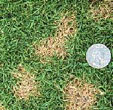
Organic Solution:
Good turf management procedures that promotes healthy turf help reduce the occurence of dollar spot. Keep the lawn mowed to a minimum height of 3 inches, dethatch the turf regularly and avoid watering in the evenings.
Non-organic Solution: Fungicides may be used to control Dollar Spot. Check with your local garden centre or hardware store for options in your area.
Problem:
This is a hot-weather fungus that produces circular patches of discoloured turf with a "smoke ring" of gray or purple that disappears later in the day.
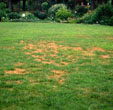
Organic Solution:
Avoid excessive use of nitrogen fertilizers especially before hot weather (it is best to fertilize in late fall and/or early spring)and dethatch regularly. Keep the lawn watered deeply to promote deep rooting and to help it recover, remember it is best to water in the mornings.
Non-organic Solution: Fungicides may be used to control Brown Patch. Check with your local garden centre or hardware store for options in your area.
Problem:
This root-infecting fungus emerges during hot humid or wet weather in stressed turf growing in poorly drained soils. Easily confused with other diseases, it appears similar to necrotic ring spot.
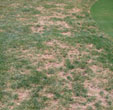
Organic Solution:
Good turf management procedures that promotes healthy turf help reduce the occurrence of Summer Patch, however when Summer Patch is severe, overseeding is probably the only option to restore the lawn.
Non-organic Solution: Fungicides may be used to control Summer Patch. Check with your local garden centre or hardware store for options in your area.
Problem:
Mainly a problem of Kentucky Bluegrass this is a serious fungus where decomposition of thatch results in sunken or depressed areas. This is difficult to control.
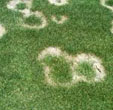
Organic Solution:
Dethatch the area and remove the debris, avoid excessive use of fertilizers. Water the lawn to a depth of at least one inch as infrequently as possible, usually no more than twice a week. Overseed with Eco-Lawn.
Non-organic Solution: Fungicides may be used to control Necrotic Ring Spot. Check with your local garden centre or hardware store for options in your area.
Problem:
Affecting mostly St. Augustine, Perennial Ryegrass and Tall Turf-type fescues, this challenging fungus emerges in hot, humid, dry weather creading reddish-brown spots on the turf. Tiny pinprick lesions quickly turn into round and oval spots that elongate the length of the grass blade. Later on it looks scorched and twisted.
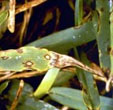
Organic Solution:
Good turf management procedures that promotes healthy turf help reduce the occurence of Gray Leaf Spot. This means watering in the mornings, not evenings and applying a slow-release fertilizer. Overseed with Eco-Lawn.
Non-organic Solution: Fungicides may be used to control Gray Leaf Spot. Check with your local garden centre or hardware store for options in your area.
Problem:
Small red ovals that develop tan centres of dead tissue with dark borders (eye spots), eventually blighting crowns and roots (melting out).
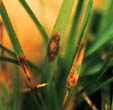
Organic Solution:
As with all lawn diseases how the turf is watered, fertilized and mowed with makes a huge difference. Avoid excessive fertilizing, water deeply no more than once a week and overseed with Eco-Lawn.
Non-organic Solution: In extreme cases fungicides may be used to control Leaf Spot. Contact your local garden centre or hardware store for options in your area.
Problem:
Grey or pinkish circles that qppear in the spring after the snow melts. This occurs when the snow comes and stays on the ground before the ground is frozen. What happens is that heat emanates from the earth creating pockets of high humidity which then create mold.
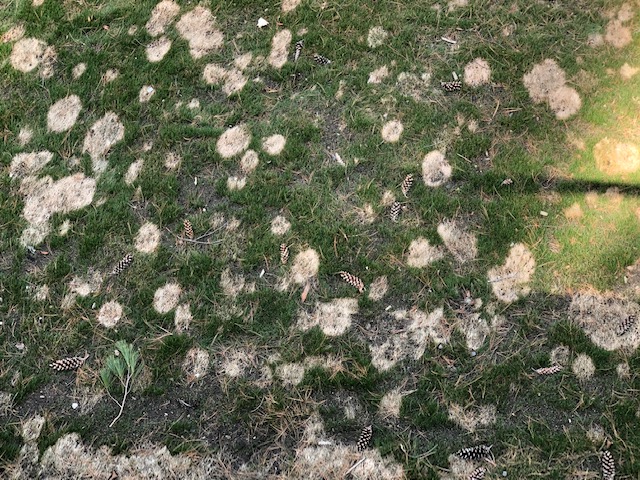
Solution:
Fortunately, in most cases, the lawn survives it. Hard rake the affected areas and remove as much of it as you can. The grass should just grow back.
In the worst case you may need to re-seed the spots but wait a few weeks to see how it recovers.
Non-organic Solution: In extreme cases fungicides may be used to control Snow Mold. Contact your local garden centre or hardware store for options in your area.
Problem:
Brown circles that resemble Dollar Spot or Brown Patch. Caused by dog urine.
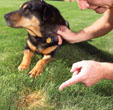
Solution:
Unfortunately, no natural turf grass can withstand highly acidic dog urine. If your dog makes those brown spots in your current lawn, it will make them in Eco-Lawn as well. The problem is really the diet of your dog. What the dog is consuming is creating a highly acidic urine. Our suggestion to alleviate this problem is to ask your vet on your next visit, how you can modify your dog's diet to counter this acidity to make it more alkaline. This will better for your lawn and your dog too! Without altering your dog's diet the only effective solution is to water the area heavily to dilute the urine but this is often just not possible and overseeding these spots becomes a maintenance requirement.
Problem:
Compacted soil and bare spots where turf is used excessively.
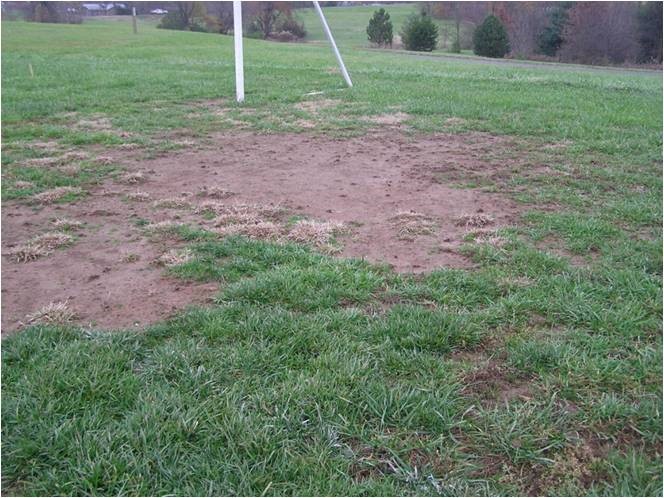
Organic Solution:
Good turf management procedures that promotes healthy turf will help. If possible, rotate foot traffic, fertilize in spring and fall, keep the lawn mowed to a 3 inch height and overseed affected areas.
Non-organic Solution: None.
Problem:
During periods of prolonged hot, dry weather, the surface of the soil hardens making moisture penetration difficult.

Organic Solution:
When you have an established Eco-Lawn this is generally not a problem due to the deep root system that Eco-Lawn creates, however, during these times and for people who live in the hotter southern climates occasional watering helps enormously.
Non-organic Solution: If moisture will not penetrate the soil due to hardening try using a wetting agent or surfectant will help break down the barriers that repel water and allow it to enter the soil.Contact your local garden centre or hardware store for options in your area. |
Experience what thousands of people across North America already know -
Grow an Eco-Lawn!
We ship seed throughout North America.
Our customer service centre and technical support team is available Monday - Friday 8 am - 4 pm Eastern Time.
1 866 476 9453
|

















